Fracture Behavior of Steel-Fiber-Reinforced High-Strength Self-Compacting Concrete: A Digital Image Correlation Analysis
Highlights
- Revealed the variation law of flexural-tensile performance of the high-strength self-compacting concrete (HSSCC) with volume fraction of steel fibers.
- Declared the influence of steel fibers on the fracture characteristics of HSSCC.
- Clarified the deformation behavior of HSSCC during its fracture process based on digital image correlation (DIC) technique.
Abstract
1. Introduction
2. Experimental Materials and Methods
2.1. Raw Materials
2.2. Preparation of Steel-Fiber-Reinforced HSSCC
2.2.1. Mixture of Steel-Fiber-Reinforced HSSCC
2.2.2. Testing Methods for Physical and Mechanical Properties
2.3. Methods of Fracture Testing and DIC Image Collection
2.3.1. Specimen Preparation
2.3.2. Fracture Performance Test and DIC Image Collection
2.4. Fracture Performance Evaluation Method
2.4.1. Fracture Toughness
2.4.2. Fracture Energy
3. Results and Discussion
3.1. Physical and Mechanical Properties of Steel-Fiber-Reinforced HSSCC
3.1.1. Workability
3.1.2. Mechanical Properties of Steel-Fiber-Reinforced HSSCC
3.2. Fracture Mechanical Properties of Steel-Fiber-Reinforced HSSCC
3.2.1. F-CMOD Curve Characteristics
3.2.2. Fracture Energy and Fracture Toughness
3.3. DIC-Based Fracture Process Analysis
3.3.1. Observation Segment Selection
3.3.2. Horizontal Displacement Cloud
3.3.3. Horizontal Strain Cloud
3.4. Fracture Behavior of Steel-Fiber-Reinforced HSSCC-Based DIC Analysis
4. Conclusions
- The incorporation of steel fibers obviously improved the flexural properties of HSSCC and deteriorated its workability. As Vf of steel fibers increased, the 28-day compressive strength and flexural strength of HSSCC exhibited an initial decrease and then an enhancement, and reached their maximum values of 110.5 MPa and 11.8 MPa at Vf of 1.2%, respectively, whereas the flexural-to-compressive ratio nearly linearly increased. The workability and compressive strength of HSSCC met the requirements of the relevant specifications for SCC and high-strength concrete of Grade C80.
- The fracture mechanics characteristics of HSSCC enhanced with an increase in Vf of steel fibers. When Vf was 1.2%, the peak load (FP), peak opening displacement (CMODP), fracture toughness (KIC), and fracture energy (GF) of steel-fiber-reinforced HSSCC increased by 23.5%, 45.4%, 11.1 times, and 20.1 times compared with those of HSSCC-0, respectively. Steel fibers significantly improved the load-bearing capacity and fracture toughness of HSSCC under flexural loading through the effects of crack bridging and energy dissipation.
- The deformation behavior during the fracture process of HSSCC was revealed by the DIC technique. In the case of HSSCC-0, the mutation zone of the horizontal displacement clouds did not form during the whole fracture, and the fracture process zones of horizontal strain clouds came into being at the load softening stage, whereas both of these zones of HSSCC-0.6 and HSSCC-1.2 occurred at the peak loading and the early loading stage, respectively. During the fracture of steel-fiber-reinforced HSSCC, both the horizontal deformation and horizontal strain magnified significantly with an increase in Vf, indicating that the increased concentration of steel fibers effectively delayed the overlap and expansion of the cracks at the tip of notched beams.
- This study integrated the DIC technology to unveil the deformation behavior of HSSCC during its fracture process and the toughening mechanism of steel fibers. In future studies, X-ray computed tomography will be employed to analyze the distribution state of steel fibers, aiming to disclose the correlation between crack orientations and their crack-arresting effects. Additionally, further investigations will be carried out to explore the degradation law of the flexural tensile deformation behavior of steel-fiber-reinforced HSSCC under freeze–thaw cycles. This endeavor is expected to provide essential data for the promotion of its engineering applications.
Author Contributions
Funding
Institutional Review Board Statement
Informed Consent Statement
Data Availability Statement
Conflicts of Interest
References
- Jalal, M.; Mansouri, E. Mechanical, rheological, durability and microstructural properties of high performance self-compacting concrete containing SiO2 micro and nanoparticles. Mater. Des. 2012, 34, 389–400. [Google Scholar] [CrossRef]
- Ramkumar, K.B.; Rajkumar, K.P.R. A Review on Performance of Self-Compacting Concrete-Use of Mineral Admixtures and Steel Fibers with Artificial Neural Network Application. Constr. Build. Mater. 2020, 261, 120215. [Google Scholar] [CrossRef]
- Tantray, M.A. Characteristic influence of carbon fibers on fresh state, mechanical properties and microstructure of carbon fiber based self-compacting concrete. Mater. Today Proc. 2021, 38, 3181–3189. [Google Scholar]
- Elik, Z.; Bingl, A.F. Fracture properties and impact resistance of self-compacting fiber reinforced concrete. Mater. Struct. 2020, 53, 50. [Google Scholar] [CrossRef]
- Abdalla, M.S.; Afzal, H.K. Strength and flexural behavior of steel fiber and silica fume incorporated self-compacting concrete. J. Mater. Res. Technol. 2021, 12, 1380–1390. [Google Scholar] [CrossRef]
- Athiyamaan, V.; Mohan Ganesh, G. Experimental, statistical and simulation analysis on impact of micro steel-Fibers in reinforced SCC containing admixtures. Constr. Build. Mater. 2020, 246, 118450. [Google Scholar] [CrossRef]
- Liu, J.; Zang, S. Fracture properties of steel fibre reinforced high-volume fly ash self-compacting concrete. Case Stud. Constr. Mater. 2023, 18, e02110. [Google Scholar] [CrossRef]
- Palacio, A.J.; Raggiotti, B.B. Development and experimental verification of a design method for steel fibre-reinforced high strength lightweight self-compacting concrete. Constr. Build. Mater. 2024, 453, 139012. [Google Scholar] [CrossRef]
- Magbool, H.M.; Zeyad, A.M. The effect of various steel fibers and volcanic pumice powder on fracture characteristics of Self-Compacting concrete. Constr. Build. Mater. 2021, 312, 125444. [Google Scholar] [CrossRef]
- Yoo, D.Y.; Yoon, Y.S. Predicting the post-cracking behavior of normal and high-strength steel-fiber-reinforced concrete beams. Constr. Build. Mater. 2015, 93, 477–485. [Google Scholar] [CrossRef]
- Gümüş, M.; Bayrak, H.; Aydın, A.C. Fracture evaluation of recycled steel fiber-reinforced geopolymers with varying compressive strength. Structures 2024, 70, 107874. [Google Scholar] [CrossRef]
- Meng, S.; Jiao, C. Effect of steel fiber-volume fraction and distribution on flexural behavior of Ultra-high performance fiber reinforced concrete by digital image correlation technique. Constr. Build. Mater. 2022, 320, 126281. [Google Scholar] [CrossRef]
- Ramkumar, K.B.; Rajkumar, K. Impact of hybrid steel fibres on fresh and mechanical properties of Self-compacting concrete. Case Stud. Constr. Mater. 2022, 17, e01274. [Google Scholar]
- Zhang, L.; Feng, M. Multi-scale study on the crack resistance and energy dissipation mechanism of modified rubberized concrete. Constr. Build. Mater. 2024, 457, 139448. [Google Scholar] [CrossRef]
- Bian, Z.; Zhang, L. Experimental study on hybrid fiber reinforced high performance concrete properties: Investigating comprehensive energy consumption capacity. Constr. Build. Mater. 2024, 443, 137682. [Google Scholar] [CrossRef]
- Xie, H.; Yang, L. Mode-I dynamic fracture evolution and energy dissipation of basalt fiber reinforced reactive powder concrete. J. Build. Eng. 2024, 98, 111011. [Google Scholar] [CrossRef]
- Liu, J.; Wang, W. Dynamic tensile and stress wave transmitting characteristics of high strength and high ductility concrete. Constr. Build. Mater. 2024, 449, 138259. [Google Scholar] [CrossRef]
- Dehghani, A.; Aslani, F. Advanced shape memory alloy fibers designed to enhance crack closure and re-centring performance in cement-based composites. Constr. Build. Mater. 2024, 415, 135095. [Google Scholar] [CrossRef]
- GB/T 50081; Standard for Test Methods of Concrete Physical and Mechanical Properties. CABP: Beijing, China, 2019.
- JGJ/T 283-2012; Technical Specification for Application of Self-Compacting Concrete. CABP: Beijing, China, 2012.
- RILEM TC265-TDK; Testing Methods for Determination of the Double-K Criterion for Crack Propagation in Concrete. RILEM: Paris, France, 2016.
- Du, Y.; Wang, X. Digital image correlation method based on Newton-Raphson method and particle swarm optimization algorithm. Comp. Eng. Appl. 2012, 48, 184–189. (In Chinese) [Google Scholar]
- Li, D.; Huang, P. Experimental study on fracture and fatigue crack propagation processes in concrete based on DIC technology. Eng. Fract. Mech. 2020, 235, 107166. [Google Scholar] [CrossRef]
- Ma, W.; Gao, D. Whole process analysis on splitting tensile behavior and damage mechanism of 3D/4D/5D steel fiber reinforced concrete using DIC and AE techniques. Constr. Build. Mater. 2024, 457, 139295. [Google Scholar] [CrossRef]
- Yu, L.; Liu, Y. Advanced monitoring of damage behavior and 3D visualization of fiber distribution in assessing crack resistance mechanisms in steel fiber-reinforced concrete. J. Build. Eng. 2024, 97, 110980. [Google Scholar] [CrossRef]


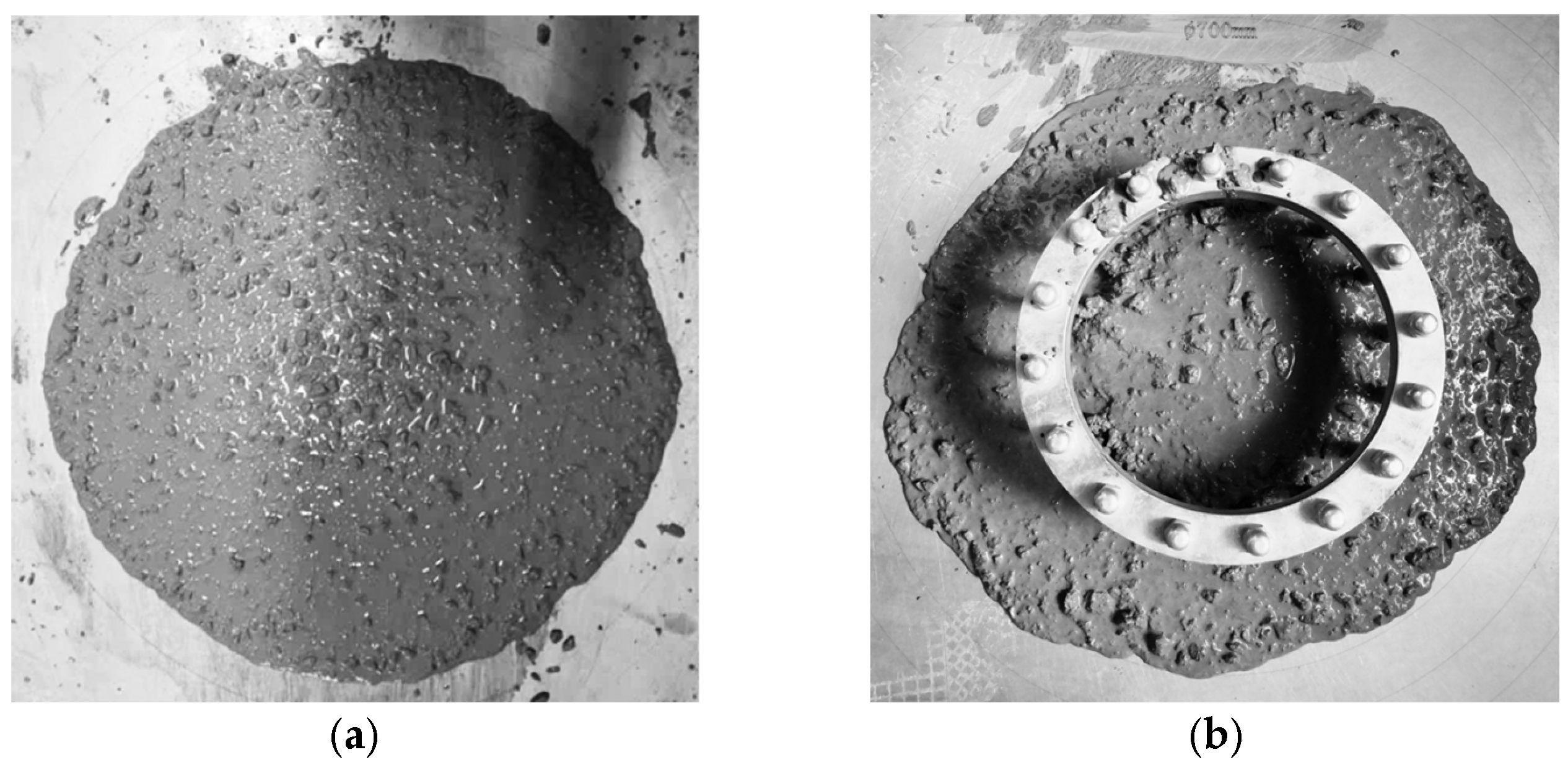
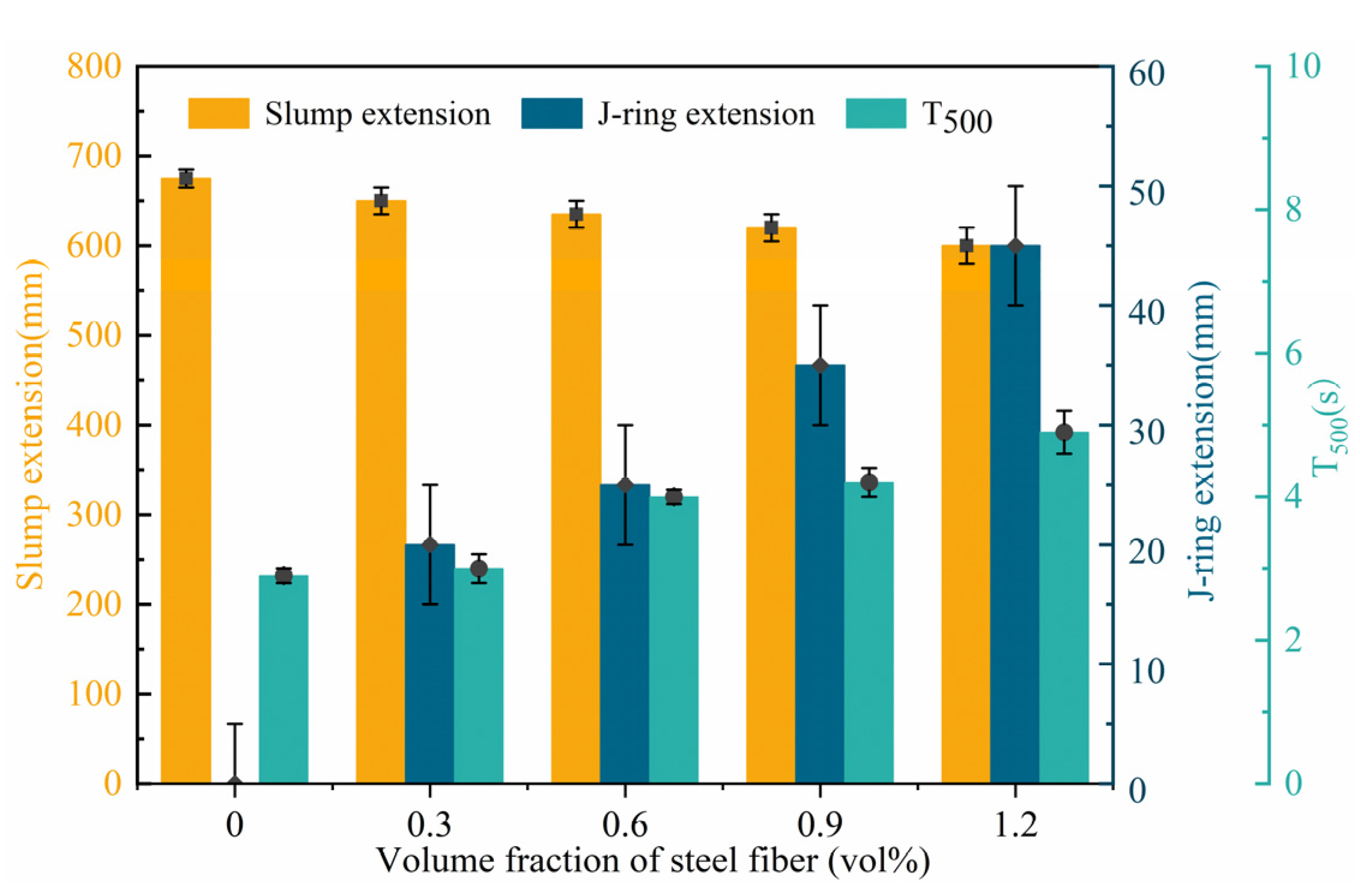
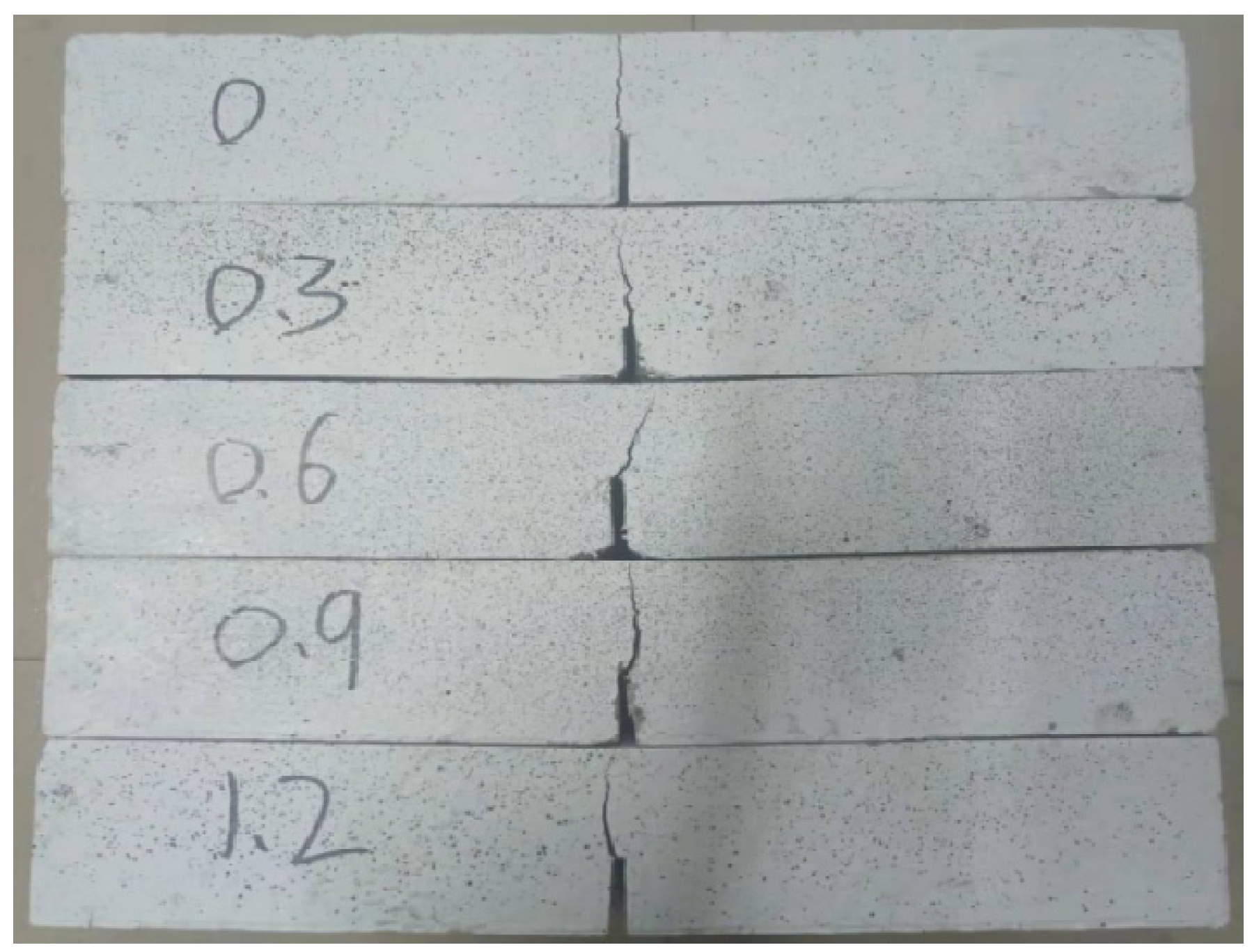
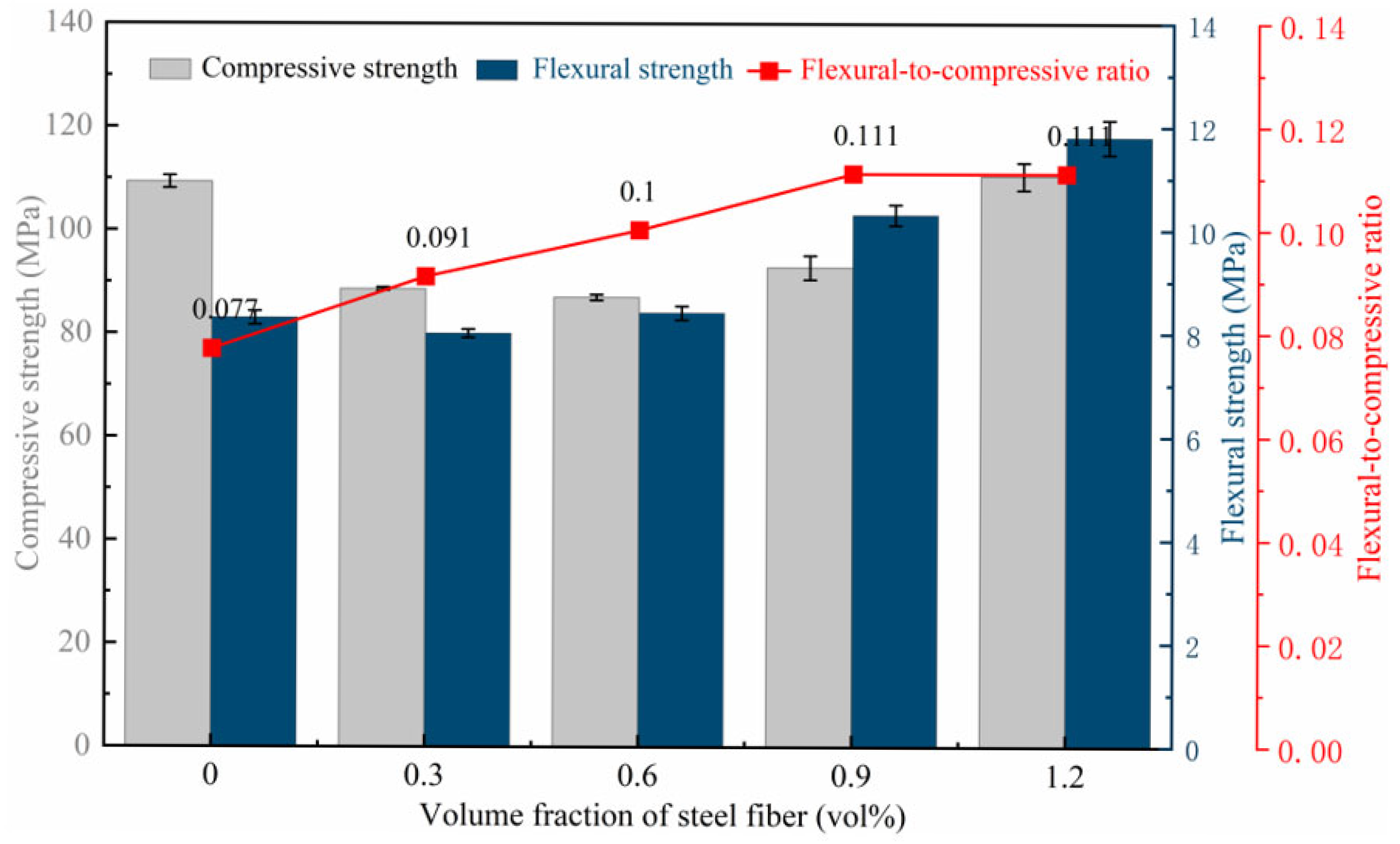

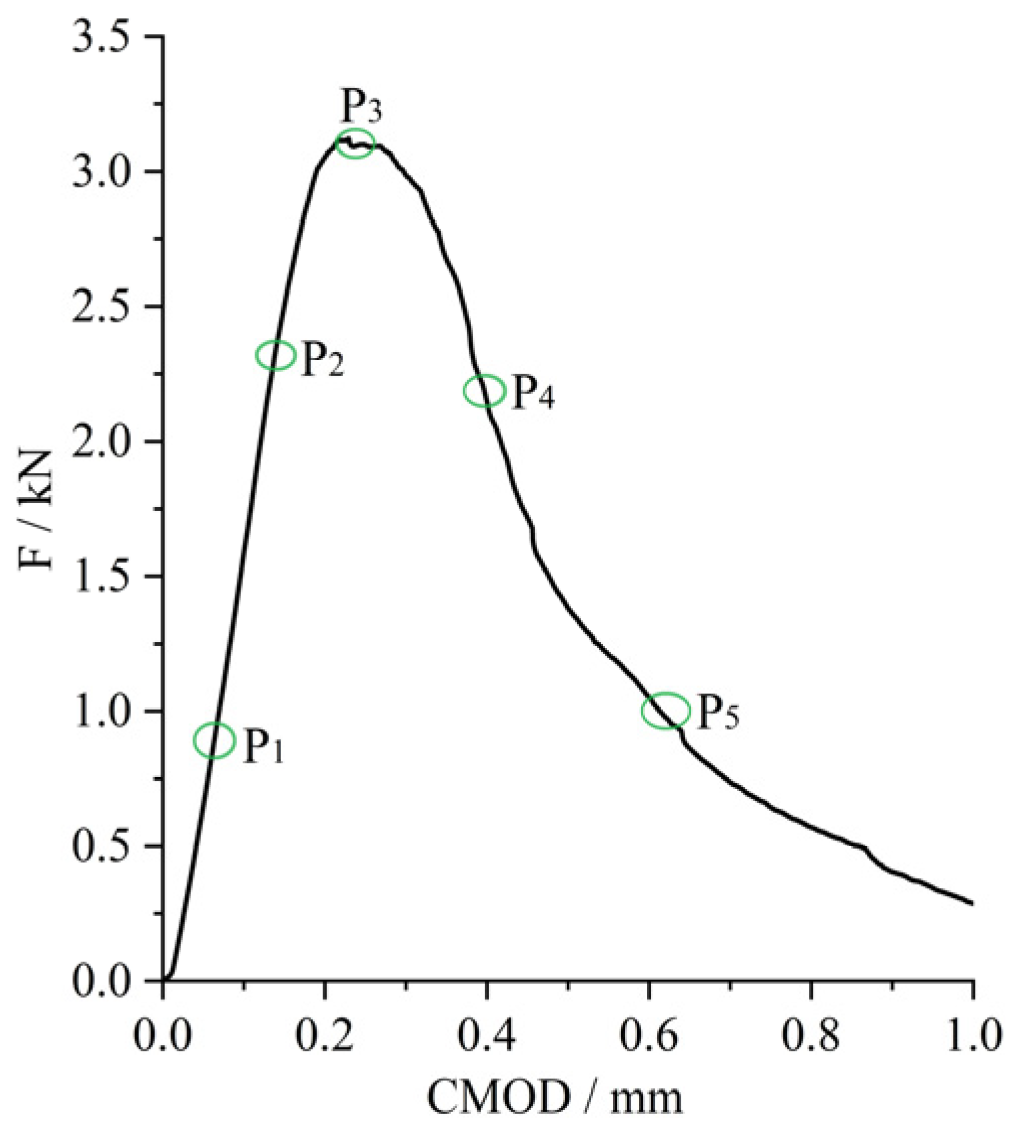
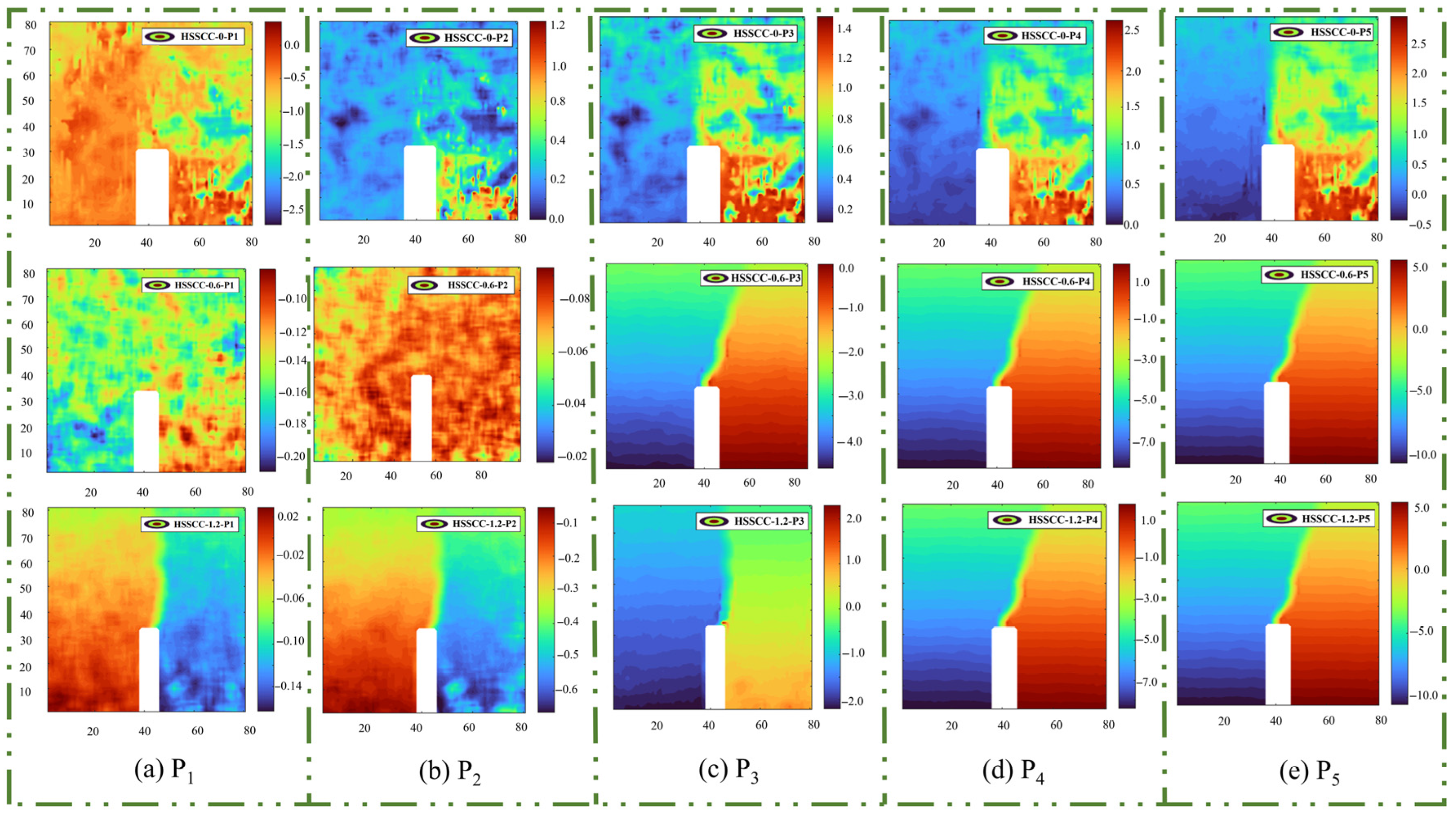
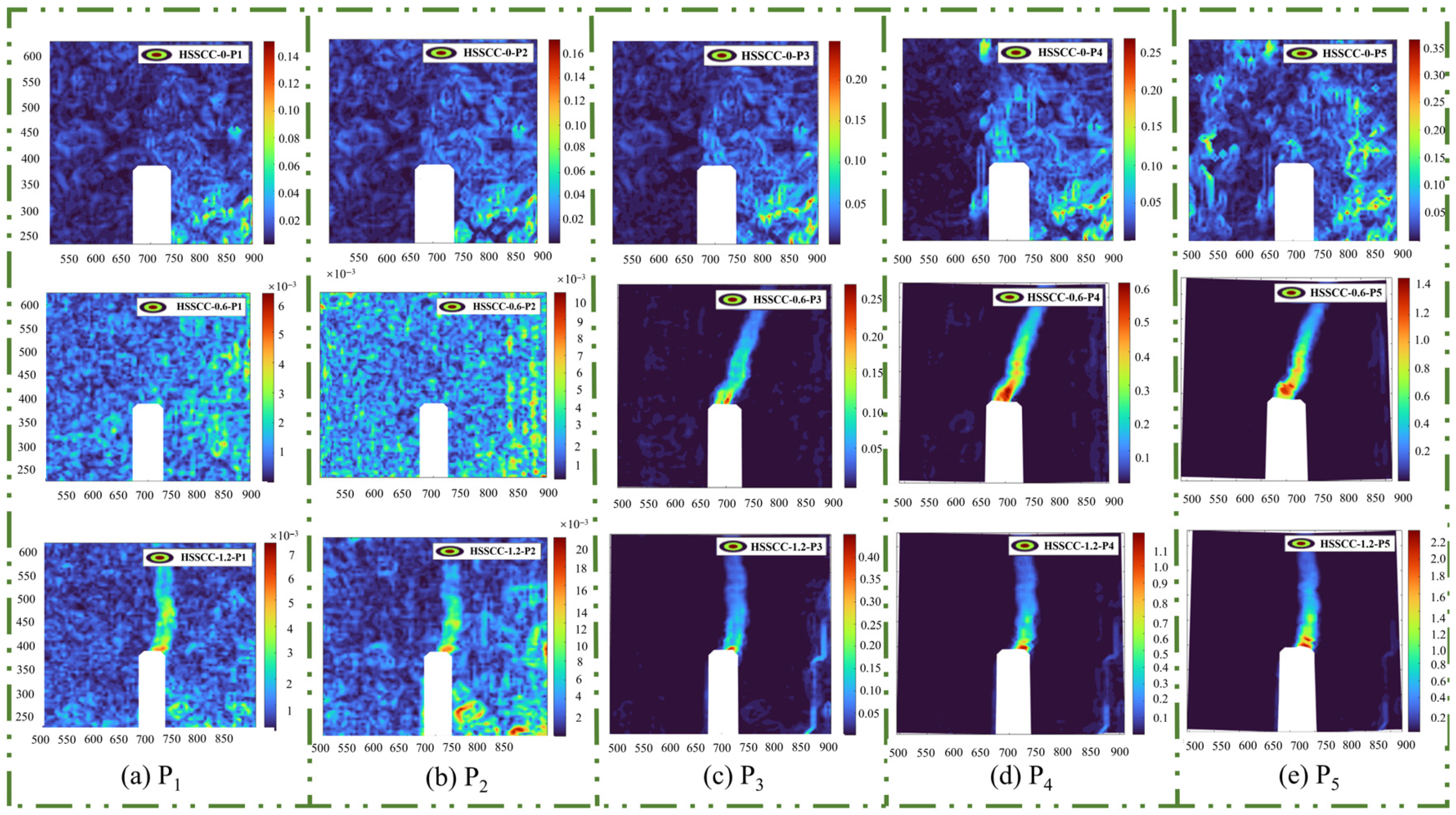
| Setting Time/Min | Compressive Strength/MPa | Flexural Strength/MPa | |||
|---|---|---|---|---|---|
| Initial | Final | 3d | 28d | 3d | 28d |
| 194 | 271 | 30.1 | 59.6 | 7.2 | 9.8 |
| SiO2 | Al2O3 | Fe2O3 | CaO | K2O | MgO | Na2O | TiO2 | Others | |
|---|---|---|---|---|---|---|---|---|---|
| Content/wt% | 29.73 | 13.46 | 1.08 | 42.38 | 0.73 | 6.76 | 0.49 | 1.56 | 3.81 |
| Aspect Ratio | Length | Elasticity Modulus | Tensile Strength |
|---|---|---|---|
| 63 | 35 ± 3 mm | 220 GPa | ≥380 MPa |
| Code | Cement | Slag | Silica Fume | Steel Fiber | Water | River Sand | Gravel | Water Reducer |
|---|---|---|---|---|---|---|---|---|
| HSSCC-0 | 435.6 | 121.0 | 48.4 | - | 193.6 | 710.4 | 941.0 | 1.5% |
| HSSCC-0.3 | 435.6 | 121.0 | 48.4 | 23.6 | 193.6 | 707.7 | 938.1 | 1.5% |
| HSSCC-0.6 | 435.6 | 121.0 | 48.4 | 47.2 | 193.6 | 704.2 | 933.7 | 1.5% |
| HSSCC-0.9 | 435.6 | 121.0 | 48.4 | 70.8 | 193.6 | 700.7 | 929.3 | 2.0% |
| HSSCC-1.2 | 435.6 | 121.0 | 48.4 | 94.4 | 193.6 | 697.2 | 924.9 | 2.0% |
| Code | FP | KIC | CMOD | GF | ||||
|---|---|---|---|---|---|---|---|---|
| Value (kN) | Increase (%) | Value (kPa·m1/2) | Increase (%) | Value (μm) | Increase (%) | Value (N·m−1) | Increase (%) | |
| HSSCC-0 | 3.6 | - | 894.6 | - | 35.5 | - | 121.5 | - |
| HSSCC-0.3 | 3.8 | 5.6 | 958.0 | 7.1 | 45.2 | 27.3 | 316.3 | 160.3 |
| HSSCC-0.6 | 4.2 | 16.7 | 1080.5 | 20.8 | 45.6 | 28.5 | 823.6 | 578.0 |
| HSSCC-0.9 | 4.3 | 19.4 | 1089.5 | 21.8 | 61.7 | 73.8 | 922.0 | 660.5 |
| HSSCC-1.2 | 4.4 | 22.2 | 1300.4 | 45.4 | 429.8 | 1110.6 | 2567.8 | 2013.4 |
Disclaimer/Publisher’s Note: The statements, opinions and data contained in all publications are solely those of the individual author(s) and contributor(s) and not of MDPI and/or the editor(s). MDPI and/or the editor(s) disclaim responsibility for any injury to people or property resulting from any ideas, methods, instructions or products referred to in the content. |
© 2025 by the authors. Licensee MDPI, Basel, Switzerland. This article is an open access article distributed under the terms and conditions of the Creative Commons Attribution (CC BY) license (https://creativecommons.org/licenses/by/4.0/).
Share and Cite
Zhang, M.; Chen, J.; Liu, J.; Yin, H.; Ma, Y.; Yang, F. Fracture Behavior of Steel-Fiber-Reinforced High-Strength Self-Compacting Concrete: A Digital Image Correlation Analysis. Materials 2025, 18, 3631. https://doi.org/10.3390/ma18153631
Zhang M, Chen J, Liu J, Yin H, Ma Y, Yang F. Fracture Behavior of Steel-Fiber-Reinforced High-Strength Self-Compacting Concrete: A Digital Image Correlation Analysis. Materials. 2025; 18(15):3631. https://doi.org/10.3390/ma18153631
Chicago/Turabian StyleZhang, Maoliang, Junpeng Chen, Junxia Liu, Huiling Yin, Yan Ma, and Fei Yang. 2025. "Fracture Behavior of Steel-Fiber-Reinforced High-Strength Self-Compacting Concrete: A Digital Image Correlation Analysis" Materials 18, no. 15: 3631. https://doi.org/10.3390/ma18153631
APA StyleZhang, M., Chen, J., Liu, J., Yin, H., Ma, Y., & Yang, F. (2025). Fracture Behavior of Steel-Fiber-Reinforced High-Strength Self-Compacting Concrete: A Digital Image Correlation Analysis. Materials, 18(15), 3631. https://doi.org/10.3390/ma18153631






